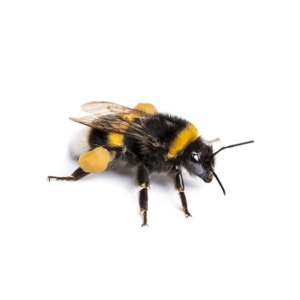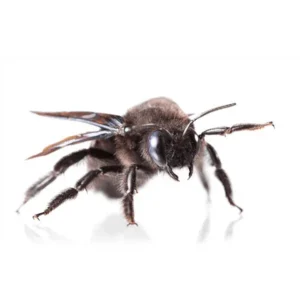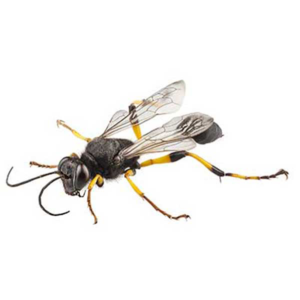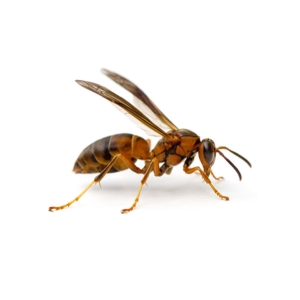European Hornet Identification
What Do European Hornets Look Like?
European hornets are large insects with a distinct appearance. They typically measure about 1 to 1.5 inches in length. Their bodies are predominantly reddish-brown with yellow or orange markings. They have six legs and two pairs of wings, with the hind wings smaller than the front wings. Their heads are yellow with large, reddish-brown eyes, and they have strong mandibles for capturing prey. European hornets also have a characteristic narrow waist and a noticeable thorax.
Unsure? We can help you to identify common bee, wasp & hornet species.
Signs of a European Hornet Infestation
European hornets are social wasps that normally build their nests in hollow trees, but will also utilize wall voids and attics of houses. Their nests will rarely appear freely suspended like the football-shaped bald-faced hornet nests. European hornet nests are generally located 6 feet or more above ground, and will occasionally be constructed on the sides of homes. In some instances, a portion of the gray, papery nest extends outside the cavity or void. An average hornet nest will have 200 to 400 workers by late summer and they can become aggressive if they feel threatened.
Habitat, Diet, Life Cycle & Stings
Where Do European Hornets Live?
European hornets are native to Europe but have been introduced to other parts of the world, including North America. They typically inhabit forested areas, woodlands, and rural areas but can also be found in suburban and urban environments. European hornets build their nests in sheltered locations such as hollow trees, wall voids, attics, or even underground. They prefer areas with access to water sources and are often attracted to outdoor lights at night, where they hunt for prey.
Diet of a European Hornets
European hornets are primarily carnivorous and feed on a variety of insects, including beetles, flies, caterpillars, and other small arthropods. They are also known to scavenge for protein-rich foods such as carrion and occasionally feed on tree sap and fruit juices. Adults capture prey with their powerful mandibles and carry it back to the nest to feed their developing larvae.
Life Cycle of a European Hornets
The life cycle of European hornets begins when a mated queen emerges from hibernation in spring to establish a new colony. She constructs a small nest and lays eggs, which hatch into larvae. The queen feeds and cares for the larvae until they pupate. After pupation, they emerge as sterile female workers, which then take over nest-building and foraging duties. Throughout the summer, the colony grows in size. In fall, new queens and males are produced, mating occurs, and fertilized queens overwinter to start new colonies the following spring.
Do European Hornets Sting?
Although large and fierce-looking, European hornets will not sting unless threatened and tend to leave people alone. However, this hornet is capable of stinging multiple times, and those who may be allergic to their venom should seek medical attention when stung. European hornets can cause issues for homeowners by nesting in barns, hollow trees in yards, wall voids, or attics. When food becomes scarce in late summer, they look for sugary foods and may destroy fruit trees. These hornets are attracted to porch lights at night and will sometimes bang up against windows, causing many a distressed homeowner. If a European hornet nest is suspected on your property, it is always best to contact a professional hornet control expert.
Are European Hornets Dangerous?
European hornets can be considered dangerous due to their ability to sting and the potential for allergic reactions. While they are not typically aggressive, they will defend their nests if threatened, which can result in painful stings. Their venom contains a mixture of toxins that can cause pain, swelling, and in some cases, allergic reactions ranging from mild to severe. It’s essential to exercise caution around European hornet nests and seek our professional wasp and bee pest removal if necessary.
European Hornet Prevention Tips
To prevent European hornets from nesting near your home:
- Seal cracks and openings in walls, roofs, and windows to prevent entry.
- Keep outdoor lights off at night, as they can attract hornets.
- Avoid leaving food and sweet beverages uncovered, as they may attract hornets.
- Regularly inspect your property for signs of hornet activity, such as nests or buzzing sounds.
- Consider planting insect-repellent plants around your property, such as mint or marigolds.
- If you encounter a nest, keep your distance and contact our professional wasp and bee pest control service for safe removal.
FAQs
Are European Hornets in the US?
Yes, European hornets (Vespa crabro) are present in the United States. They were introduced to North America in the 1800s and have since become established in various regions, particularly in the eastern United States. European hornets are considered invasive in North America and can be found in forested areas, suburban neighborhoods, and urban environments. They are larger than many native hornet species and are known for their distinctive appearance and aggressive defense of their nests.
Are European Hornets Gentle?
European hornets are generally not aggressive unless their nest is threatened or disturbed. While they may exhibit defensive behavior if provoked, they are not as aggressive as some other hornet species. European hornets are primarily focused on foraging for food and caring for their colony, rather than seeking out conflicts with humans. With proper respect and caution, interactions with European hornets can often be peaceful, and they may even be considered beneficial for their role in controlling insect populations.
What is the Difference Between a killer Hornet and a European Hornet?
The “killer hornet” typically refers to the Asian giant hornet (Vespa mandarinia), whereas the European hornet (Vespa crabro) is a different species native to Europe and parts of Asia. The Asian giant hornet is significantly larger than the European hornet, with a body length of up to 2 inches compared to the European hornet’s 1 to 1.5 inches. Additionally, Asian giant hornets have a more aggressive reputation and are known for their potent sting, whereas European hornets are generally less aggressive and pose less of a threat to humans.





